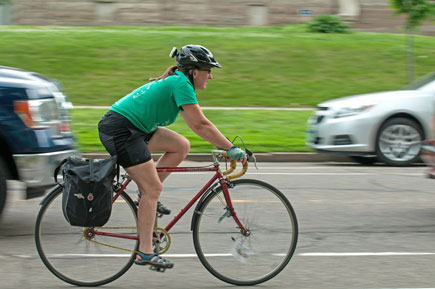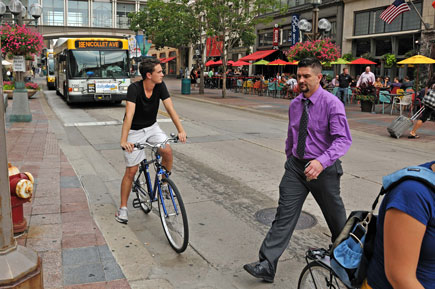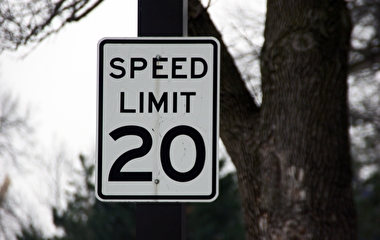Giving people , MnDOTmore options to bike or walk to their destinations has been a high priority for transportation planners in recent years. But as the number of pedestrians and bicyclists using the transportation system increases, so does the potential for serious—or even deadly—crashes involving these high-risk road users.
“To best prevent bicycle and pedestrian crashes, transportation planners need a better idea of how many people are using nonmotorized transportation and what their exposure to risk is,” says Greg Lindsey, a professor in the University of Minnesota’s Humphrey School of Public Affairs and researcher at the Roadway Safety Institute.
As part of a project sponsored by the Institute, Lindsey is working to develop new methods and tools to help transportation engineers estimate bicycle and pedestrian traffic volumes and assess these nonmotorized travelers’ exposure to risk.
So far, Lindsey and his team have collected bicycle and pedestrian counts in several Minnesota case communities, ranging in size from the large Twin Cities metropolitan area to much smaller cities such as Grand Marais and Bemidji. Because most studies of exposure and risk have occurred in larger urban areas, Lindsey expects the results from the smaller communities to be particularly useful.
With these counts complete, the researchers are developing models to adjust and extrapolate the data to measure the average annual daily number of bicyclists and pedestrians for specific road segments and networks. They are also creating models that estimate exposure to risk for nonmotorized traffic and then combining those models with traffic volume estimates to help predict and better understand potential for being involved in a crash or other hazardous situation. This information will help illustrate the need for countermeasures or different traffic controls at specific locations.
“Within our case study communities, these results will be used to inform decision making about strategies that can reduce the risk of crashes for bicyclists and pedestrians,” says Lindsey. “In addition, they will be useful for developing performance indicators and measuring progress toward them.”
Lindsey began work on the project in 2014. While the final study has not yet been published, early papers based on the research are already earning national recognition. In a paper presented at the Transportation Research Board’s 2016 Annual Meeting, researchers outlined a simplified model that can be used to easily generate spatial estimates of pedestrian and bicyclist traffic volumes in the field.
“Our results indicate that this simplified model can explain nearly as much of the observed variation in bicycle and pedestrian traffic as more complex, fully-specified models while offering the advantage of being easier to apply and interpret,” says Lindsey. “We were also able to confirm previous research that shows that factors influencing pedestrian traffic and bicycle traffic are different, and as a result these two modes must be modeled separately.”
Work on this project is ongoing, and a final report will be published later this year. The research is expected to have many benefits, including an improved understanding of bicycle and pedestrian traffic volumes and patterns; new tools, models, and guidance for monitoring traffic and assessing exposure to risk; and new insights on the relationship between exposure and risk, Lindsey says.




